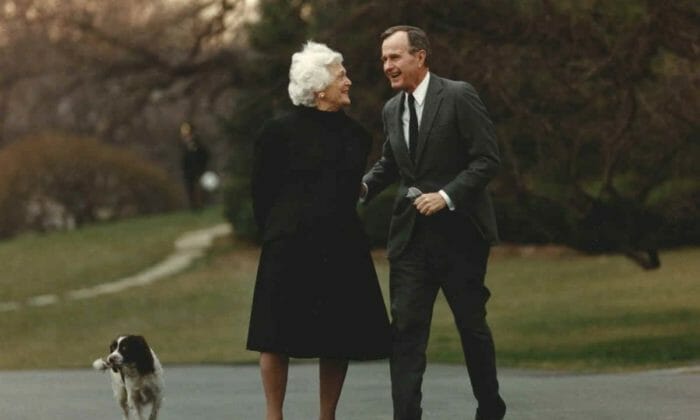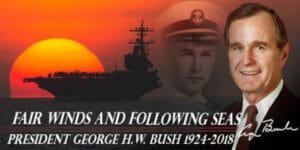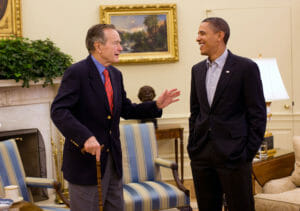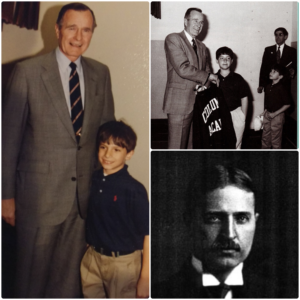In his 1988 presidential campaign, Bush famously promised–and would later regret–these words: “Read my lips, no new taxes.” Two years later, the president was presented with a bipartisan budget bill that called for new revenue, and he realized what needed to be done. The Reagan administration had tripled the deficit, and there was a price to be paid. Bush courageously chose to put the country’s interest above his own. He understood that moving the the bill to the Senate and House floors would be political suicide. Democrats would take advantage of his “broken promises” in the re-election campaign. Republicans would never forgive him.
Former Wyoming U.S. Senator, Alan Simpson, remembers Bush’s words regarding his decision: “When the really tough choices come, it’s the country, not me. It’s not about Democrats or Republicans, it’s for our country that I fought for.”
While the above history speaks to President Bush’s travails and accomplishments, many Americans may not know of his patriotism and valor, beginning at a young age.
George Bush turned 18 on the day of his high school graduation. He had been accepted into Yale University, the alma-mater of his father, Prescott Bush, a Connecticut Senator and Ohio-native. The senior Bush pressured his son to attend Yale, yet George enlisted in the U.S. Navy after hearing news of the attacks on Pearl Harbor.
One year later, and now the youngest U.S. Navy aviator, Bush was deployed to the Philippines. He was assigned to an aircraft carrier in the Japanese-thick waters of the Pacific. He was awaiting takeoff clearance for a bombing mission when his carrier went under attack. Bush was forced to sit anxiously in the pilot seat, knowing that his plane was full of explosives, as the carrier battled against the Japanese onslaught. He and his crewmen barely escaped with their lives during the attack, yet they still had to remain calm, because flight clearance was given immediately after the battle.
Three years later, he was promoted to lieutenant and was assigned to more missions in the Pacific. One day, as he was flying over the Bonin Islands, his aircraft faced enemy fire. His plane was hit, and he could see the black smoke spilling from the engine. But he was determined to finish his mission, successfully dropping four catastrophic bombs on the area. Bush quickly veered course from the island, knowing that the plane had little time. He executed a quick turn to ensure a clear bail for his crewmen, yet his parachute was the only one to open. He landed in treacherous, dark waters and inflated his rescue raft. He bobbed alone in the vastness of the Pacific with enemies above and below. He later said, “I didn’t know what was going to happen for a couple hours, and then, out of the sea, came a periscope, and then a submarine. Thank God it turned out to be ours.”
For this mission, Bush would later be awarded the Distinguished Flying Cross.
The Navy’s Tribute to President Bush (Department of Defense)
After the war, he married his high school sweetheart, Barbara Pierce. Their first child was named after his father and eventually followed him to the presidency. Their second child was a precious daughter, Robin, who at the age of three, lost her life to leukemia. Her parents never got over her loss. Five years after Robin’s death, Bush wrote to his mother:
“We need some starched crisp frocks to go with all our torn-kneed blue jeans and helmets. We need some soft blond hair to offset those crew cuts. We need a dollhouse to stand firm against our forts and rackets and thousand baseball cards . . . We need a little one who can kiss without leaving egg or jam or gum. We need a girl. We had one once. She’d fight and cry and play and make her way just like the rest but there was about her a certain softness. She was patient. Her hugs were just a little less wiggly. But she is still with us. We need her and yet we have her. We can’t touch her and yet we can feel her. We hope she’ll stay in our house for a long, long time.”
Bush wrote poignant letters throughout his lifetime that told the story of a man who faced crises and tragedies with courage, selflessness and strength.
Historians are beginning to revisit the legacy of George H.W. Bush’s presidency. He provided a steady international hand in the aftermath of the collapse of the Soviet Union. He advocated for the reunification of Germany following the fall of the Berlin Wall. Bush successfully negotiated the North American Free Trade Agreemen (NAFTA). Despite populist outcry, the agreement created the world’s largest free trade zone, consisting of 450 million people. It has increased the gross domestic product (GDP) in the United States by 23.46 trillion dollars, and it has created five million U.S. jobs.
Arguably, however, his greatest accomplishment may have been Operation Desert Shield, commonly known as the first Gulf War. He was a respected leader who built a coalition of 35 nations to repel Saddam Hussein’s Iraqi forces from Kuwait, preventing the territorial expansion of a brutal dictator.
Presidents Bush and Obama meet in the Oval Office, 2010. (Wikimedia Commons)
It is also important to note that he is remembered for his humility. The Secret Service considers President Bush as a favorite president, for acts as simple as moving around their schedules in order for them to return home to their families for the holidays. He treated the people who cleaned his office and the people who served in his cabinet equally. We honor Bush not only for his service but for his modesty, as well.
The Columbus Academy is proud to have a connection with the Bush family. Head of School, Melissa Soderberg, writes:
“Samuel Prescott Bush, the grandfather of our 41st President and great-grandfather of our 43rd President, was one of the nine founders of Columbus Academy and served on the school’s Board of Directors for its first three decades.
Hired by Frank Rockefeller, brother of Standard Oil’s John D. Rockefeller, to be the general manager of a railroad parts manufacturer known as Buckeye Steel Casting Company, S.P. Bush became close friends with James L. Hamill, who believed there needed to be an exceptional educational option in Central Ohio rivaling the top East Coast boarding schools.
With the help of several other community leaders such as Foster Copeland (president of City National Bank), B. Gwynne Huntington (banker at Huntington Bank) and Kenneth Wood (a founder of the Ohio Paper Company), they purchased a building with four acres of land on Nelson Road, hired Frank Van Syckel from Princeton University as the first Headmaster and established Columbus Academy in 1911 while charging $250 a year per student. The rest, as they say, is history . . . our history.
George H.W. Bush visited Columbus in the early 1990s, and Academy students Dean Bring ’01 and Dr. Ben Bring’03 had the opportunity to present him with a Columbus Academy sweatshirt, a moment captured on the cover of Academy magazine.”
President George H.W. Bush visits Academy in 1992. Ben Bring’03 (left) and Dean Bring’01(top right). The President’s grandfather, Samuel Prescott Bush, who is interred at Greenlawn Cemetery, Columbus, Ohio. (Collage created by Andrew Barren’22)
George H.W. Bush would later honor his grandfather by visiting the school. (Pictured Dean Bring’01 and Ben Bring’03) For the school’s 2011 centennial, the president provided this video:
From the Columbus Academy community, we offer our condolences to the Bush family.
As the U.S. Navy said in a tribute, “Fair winds and following seas, Sir. We have the watch.” President Bush, thank you.
Special thanks to Laura Miller and Bob Lee for their contributions to this article.











